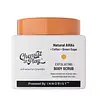What's inside
What's inside
 Key Ingredients
Key Ingredients

 Benefits
Benefits

 Concerns
Concerns

 Ingredients Side-by-side
Ingredients Side-by-side

Coffea Arabica Seed Powder
AbrasiveSucrose
HumectantSodium Chloride
MaskingSorbitol
HumectantJuglans Regia Shell Powder
AbrasiveTheobroma Cacao Husk
AbrasiveWater
Skin ConditioningSodium Cocoyl Isethionate
CleansingPrunus Amygdalus Dulcis Oil
Skin ConditioningDicaprylyl Carbonate
EmollientIsopropyl Palmitate
EmollientGlycerin
HumectantParfum
MaskingAstrocaryum Murumuru Seed Powder
AbrasiveOlea Europaea Fruit Oil
MaskingSodium Benzoate
MaskingPotassium Sorbate
PreservativeCocos Nucifera Oil
MaskingVaccinium Myrtillus Fruit/Leaf Extract
AstringentTocopheryl Acetate
AntioxidantSaccharum Officinarum Extract
MoisturisingCitrus Limon Fruit Extract
MaskingAcer Saccharum Extract
Skin ConditioningOryza Sativa Cera
Skin ConditioningCeramide Ag
HumectantPhospholipids
Skin ConditioningSphingolipids
EmollientCoffea Arabica Seed Powder, Sucrose, Sodium Chloride, Sorbitol, Juglans Regia Shell Powder, Theobroma Cacao Husk, Water, Sodium Cocoyl Isethionate, Prunus Amygdalus Dulcis Oil, Dicaprylyl Carbonate, Isopropyl Palmitate, Glycerin, Parfum, Astrocaryum Murumuru Seed Powder, Olea Europaea Fruit Oil, Sodium Benzoate, Potassium Sorbate, Cocos Nucifera Oil, Vaccinium Myrtillus Fruit/Leaf Extract, Tocopheryl Acetate, Saccharum Officinarum Extract, Citrus Limon Fruit Extract, Acer Saccharum Extract, Oryza Sativa Cera, Ceramide Ag, Phospholipids, Sphingolipids
Physalis Peruviana Extract
Skin ConditioningCoffea Arabica Seed Extract
MaskingCaffeine
Skin ConditioningAscorbic Acid
AntioxidantTocopherol
AntioxidantWater
Skin ConditioningCocamidopropyl Betaine
CleansingSodium Methyl Cocoyl Taurate
CleansingDisodium Cocoyl Glutamate
CleansingSodium Cocoyl Isethionate
CleansingGlycerin
HumectantSodium Benzoate
MaskingPhenoxyethanol
PreservativeCocamide Mea
EmulsifyingRubus Idaeus Fruit Extract
AstringentFragaria Ananassa Fruit Extract
Skin ConditioningVaccinium Macrocarpon Fruit Extract
AstringentSodium Lauroyl Lactylate
EmulsifyingMethoxycinnamidopropyl Hydroxysultaine
UV AbsorberTocotrienols
Skin ConditioningSodium Gluconate
Skin ConditioningParfum
MaskingCitric Acid
BufferingCI 16035
Cosmetic ColorantCI 42090
Cosmetic ColorantCI 19140
Cosmetic ColorantPhysalis Peruviana Extract, Coffea Arabica Seed Extract, Caffeine, Ascorbic Acid, Tocopherol, Water, Cocamidopropyl Betaine, Sodium Methyl Cocoyl Taurate, Disodium Cocoyl Glutamate, Sodium Cocoyl Isethionate, Glycerin, Sodium Benzoate, Phenoxyethanol, Cocamide Mea, Rubus Idaeus Fruit Extract, Fragaria Ananassa Fruit Extract, Vaccinium Macrocarpon Fruit Extract, Sodium Lauroyl Lactylate, Methoxycinnamidopropyl Hydroxysultaine, Tocotrienols, Sodium Gluconate, Parfum, Citric Acid, CI 16035, CI 42090, CI 19140
Ingredients Explained
These ingredients are found in both products.
Ingredients higher up in an ingredient list are typically present in a larger amount.
Glycerin is already naturally found in your skin. It helps moisturize and protect your skin.
A study from 2016 found glycerin to be more effective as a humectant than AHAs and hyaluronic acid.
As a humectant, it helps the skin stay hydrated by pulling moisture to your skin. The low molecular weight of glycerin allows it to pull moisture into the deeper layers of your skin.
Hydrated skin improves your skin barrier; Your skin barrier helps protect against irritants and bacteria.
Glycerin has also been found to have antimicrobial and antiviral properties. Due to these properties, glycerin is often used in wound and burn treatments.
In cosmetics, glycerin is usually derived from plants such as soybean or palm. However, it can also be sourced from animals, such as tallow or animal fat.
This ingredient is organic, colorless, odorless, and non-toxic.
Glycerin is the name for this ingredient in American English. British English uses Glycerol/Glycerine.
Learn more about GlycerinParfum is a catch-all term for an ingredient or more that is used to give a scent to products.
Also called "fragrance", this ingredient can be a blend of hundreds of chemicals or plant oils. This means every product with "fragrance" or "parfum" in the ingredients list is a different mixture.
For instance, Habanolide is a proprietary trade name for a specific aroma chemical. When used as a fragrance ingredient in cosmetics, most aroma chemicals fall under the broad labeling category of “FRAGRANCE” or “PARFUM” according to EU and US regulations.
The term 'parfum' or 'fragrance' is not regulated in many countries. In many cases, it is up to the brand to define this term.
For instance, many brands choose to label themselves as "fragrance-free" because they are not using synthetic fragrances. However, their products may still contain ingredients such as essential oils that are considered a fragrance by INCI standards.
One example is Calendula flower extract. Calendula is an essential oil that still imparts a scent or 'fragrance'.
Depending on the blend, the ingredients in the mixture can cause allergies and sensitivities on the skin. Some ingredients that are known EU allergens include linalool and citronellol.
Parfum can also be used to mask or cover an unpleasant scent.
The bottom line is: not all fragrances/parfum/ingredients are created equally. If you are worried about fragrances, we recommend taking a closer look at an ingredient. And of course, we always recommend speaking with a professional.
Learn more about ParfumSodium Benzoate is a preservative. It's used in both cosmetic and food products to inhibit the growth of mold and bacteria. It is typically produced synthetically.
Both the US FDA and EU Health Committee have approved the use of sodium benzoate. In the US, levels of 0.1% (of the total product) are allowed.
Sodium benzoate works as a preservative by inhibiting the growth of bacteria inside of cells. It prevents the cell from fermenting a type of sugar using an enzyme called phosphofructokinase.
It is the salt of benzoic acid. Foods containing sodium benzoate include soda, salad dressings, condiments, fruit juices, wines, and snack foods.
Studies for using ascorbic acid and sodium benzoate in cosmetics are lacking, especially in skincare routines with multiple steps.
We always recommend speaking with a professional, such as a dermatologist, if you have any concerns.
Learn more about Sodium BenzoateSodium cocoyl isethionate is a natural ingredient from coconut oil. It is an ultra gentle cleanser that gives a nice foam without drying the skin or impacting the skin barrier.
The amount of foam created depends on the amount of sodium cocoyl isethionate used in the product.
This ingredient also helps improve the spreadability of a product.
Learn more about Sodium Cocoyl IsethionateWater. It's the most common cosmetic ingredient of all. You'll usually see it at the top of ingredient lists, meaning that it makes up the largest part of the product.
So why is it so popular? Water most often acts as a solvent - this means that it helps dissolve other ingredients into the formulation.
You'll also recognize water as that liquid we all need to stay alive. If you see this, drink a glass of water. Stay hydrated!
Learn more about Water